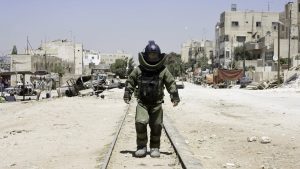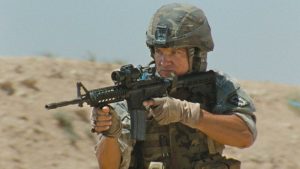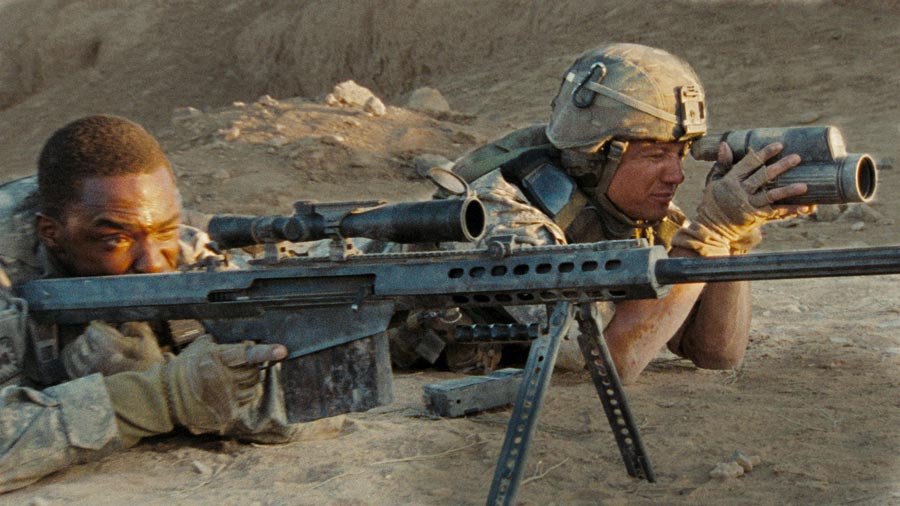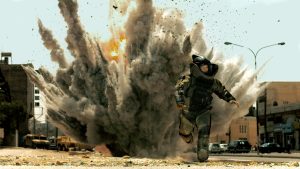Introduction:
The film The Hurt Locker is an American war film released in 2008. Written by Mark Boal and directed by Kathryn Bigelow, the movie displays the memorable events faced by units of veterans during the Iraq war. Director Bigelow uses specific techniques to emphasize the daring nature portrayed by the main character and how it impacts the tensions between characters.
Summary:
The movie begins in Banghad 2004, three soldiers of an army bomb disposal unit are in operation to defuse an improvised explosive device (IED). The unit leader, Matt Thompson, was killed by the overpressure of the bomb during this operation while he was still in the kill zone. Soon after Thompson’s death, a new unit leader replaced him. William James is shown to have a risk-taking and aggressive nature, this leads to various conflicts between the rest of the soldiers. His failure to follow protocol made his comrade soldiers think of him as reckless and many disagreements and incompatibility is encountered throughout the film. But the film also depicted James’s internal culpability and guilt when his unit was called in to assist the situation of a human bomb. A man was forced to wander into a military unit with time bombs strapped and locked onto his body. Inhumanity of the war is depicted by the brutality of humanity’s actions. When James failed to disarm the bombs on the mans body and was forced to flee, he turned his face towards the explosion of the bomb last minute. This scene provided the audience with extreme details and formed a representation of James’s guilt for not being able to save the man.
What I Liked about it:
The director of this film used very shaky and obscure scenes throughout to illustrate the uncertainty and tensions the veterans are forced to face in addition to the burden of dangers. The frequent use of handheld camera scenes helps to display a lot of unstable moves, sudden pans and quick focus changes helps me to realize that the overall style of this movie is filmed in “documentary style.” Throughout the scenes in which the army unit is on mission to defuse the bomb, the establishing shots used by the movie to show the location of each spot is very unique. Scenes establishing the above types of situations use mostly wide-angle lenses, and most shots are usually taken from a high perspective like the rooftop of a building. I also adored the POV shots used throughout, especially with the techniques of having the audience’s viewpoints zoomed in to look through the rifle scope. This helps me as a viewer to relate more towards the situational conflicts of the characters and experience what they’re feeling.
In addition to the use of strong music and sound effects, the film provided the audience with a tense and suspenseful feeling throughout. Music composers of this film used guitar, piano and violin in order for the audience to feel a sense of sympathy for the soldiers. The gloomy and unease music used leave the audience wondering the possible events that might happen and the dangerous environments of war many soldiers are forced to face. This film also used various unique aspects to further improve the viewing of the audience. Throughout the movie, almost every mission scene included certain shots showing the outside observers. The addition of the citizens of Iraq looking through the windows and roofs created a sense of uncertainty and awareness. This really helped to grasp my attention more into the film. The use of close up shots towards the eye of a human helped to illustrate the intense moments of the movie. An example of this is the memorable taxi driver scene. The shots cutting between the extreme zoom up of the eye of the taxi and the gun pointing at him magnifies the emotional feelings the characters are trying to inform the audience.
Conclusion:
In conclusion, this film really grabbed my interest and I love the main message the film portrayed in regards to “war is a drug.” The Hurt Locker presents a masterly reflection of the daily lives of many soldiers that’s still sacrificing their personal lives in order to maintain peace within a country. The harsh reality the movie concentrated towards throughout the various scenes showed the audience how war is a “drug” and many veterans abandon everything just to remain devoted towards their duty and job.

Production notes and credits:
Studios: Voltage Pictures, Grosvenor Park Media, Film Capital Europe Funds, First Light Productions, Kingsgate Films, and Summit Entertainment
Director: Kathryn Bigelow
Writer: Mark Boal
Music: Marco Beltrami and Buck Sanders
Cast:
Jeremy Renner (Sgt. William James)
Anthony Mackie (Sgt. J.T. Sanborn)
Brian Geraghty (Specialist Owen Eldridge)
Christian Camargo (Col. John Cambridge)
Christopher Sayegh (Beckham)
References:
The Hurt Locker Film Analysis – Academic Master (academic-master.com)
The Hurt Locker | Plot, Cast, Awards, & Facts | Britannica
The Hurt Locker movie review & film summary (2009) | Roger Ebert



